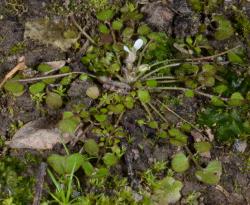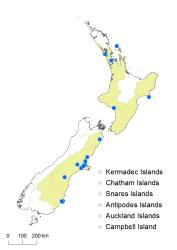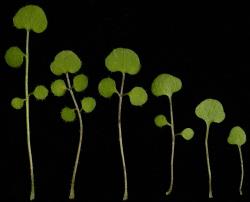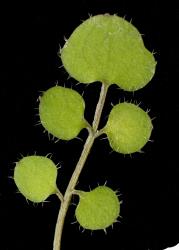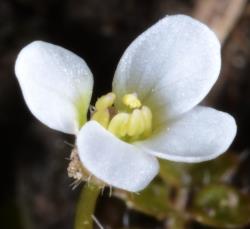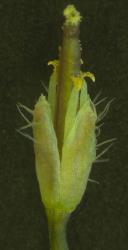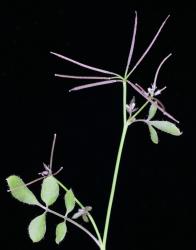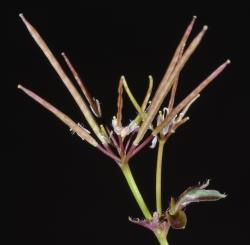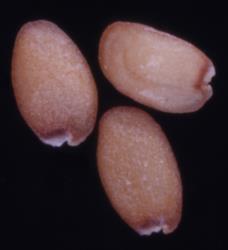Perennial herb, single rosette or with short lateral branches. Leaves up to 120 mm long, pinnatisect; lamina 4.0–55.0 × 2.5–25.0 mm, green to green-brown, membranous, glabrate to sparsely hairy on abaxial surface, sparsely to moderately hairy on adaxial surface, margin and petiole, margin hairs usually conspicuous; hairs 0.4–0.6 mm long, spreading to patent; petiole up to 65 mm long, green-brown to red-brown. Terminal pinna 2.0–14.0 × 2.0–17.0 mm, simple, orbicular, broadly orbicular, orbicular-reniform to broadly orbicular-reniform; margin entire, often with 2 distinct shallow lobes, with 2 usually distinct hydathodes; apex obtuse, usually with a distinct hydathode; base usually truncate to weakly cordate, or occasionally obtuse; margin and main veins on abaxial surface green-brown to red-brown. Lateral pinnae 2–6, 1.0–10.0 × 1.0–10.0, simple, orbicular, broadly orbicular, to broadly elliptic-orbicular; margin entire, sometimes shallowly lobed, usually with 2 usually distinct hydathodes; apex obtuse; base usually truncate to weakly cordate, or occasionally obtuse; margin and main veins on abaxial surface green-brown to red-brown; petiolule usually distinct, 0.2–8.0 mm long, green-brown to red-brown. Cauline leaves similar to rosette leaves but smaller, narrower and more angular, with fewer lateral pinnae, pinnae bases attenuate to cuneate; terminal pinna up to 14.0 × 6.0 mm, lateral pinnae up to 8.0 × 4.5 mm. Inflorescence with solitary flowers or 1–3 corymbs, corymbs 2–8-flowered; peduncle up to 150 mm long, 0.5–1.0 mm diam. at base, spreading to ascending, glabrous to sparsely hairy. Pedicels 5.0–20.0 mm long, 0.2–0.5 mm diam., glabrous to sparsely hairy. Sepals 1.3–1.5 × 0.4–0.6 mm, elliptic-oblong, saccate, green-brown to red-brown; sparsely hairy, hairs spreading to patent, 0.2–0.4 mm long; margin white and membranous, apex obtuse, base truncate. Petals 1–4 or absent; 3.0–3.5 × 1.0–1.5 mm, white, limb obovate; apex obtuse; base cuneate, tapering to a 0.7–1.0 mm long claw. Stamens 4–6; median filaments 2–4, 1.8–1.9 mm long; lateral filaments 2, 1.5–1.7 mm long; anthers 0.3–0.4 mm long, cream to pale yellow, when dehiscent held at a similar height to or slightly below the stigma. Ovary 1.9–2.0 mm long, 0.3–0.5 mm diam., ± terete, green-brown to red-brown, glabrous; ovules 26–34; style c. 0.2 mm long, ± terete; stigma 0.3–0.4 mm diam. Siliques 8.0–20.0 × 0.7–0.8 mm, glabrous, weakly torulose, style 0.7–1.2 mm long; valves usually red-brown or sometimes green at maturity and when dehiscent; replum 0.3–0.35 mm wide. Seeds 0.9–1.0 mm long, 0.5–0.7 mm wide, 0.3–0.4 mm thick, oblong, pale green to yellow-green; wing absent.
Cardamine heleniae is distinguished from C. corymbosa by its conspicuous hydathodes on the leaflet margin, usually distinct petiolules, conspicuously hairy leaf margins, narrow and angular cauline leaflets, siliques that are green-brown to reddish-brown and narrow, and oblong seeds.
North Island: Auckland, Gisborne, Taranaki, Southern North Island.
South Island: Marlborough, Canterbury, Otago.
Cardamine heleniae is known from collections made throughout New Zealand, albeit with a sparse distribution, but it has probably been under-collected and it is likely it will be shown to be more common. The North Island collections from widely separated areas provide little additional distributional information, but it is likely to have been under-collected. The available distribution and habitat data indicate that C. heleniae may occur naturally in the eastern South Island. If the natural distribution of C. heleniae is the eastern South Island, its natural abundance may have reduced due to a significant loss and degradation of habitat, such as has occurred with, for example, the threatened Nationally Critical Olearia adenocarpa (Asteraceae) (Heenan & Molloy 2004; de Lange et al. 2018).
There is considerable uncertainty about the habitats of Cardamine heleniae since it is known only from a few wild locations, but its occurrence on limestone and mudstone at a number of sites indicates that it likes base-rich substrates (Heenan 2017). Cardamine heleniae has strong, weedy tendencies and often occurs as a weed in amenity gardens, lawns, and nursery pots.
Cardamine heleniae is assessed as having a conservation status of Data Deficient (de Lange et al. 2018), because its natural distribution, habitats, and the number and size of the populations are not known with certainty.
Flowering July–December; Fruiting July–February.



